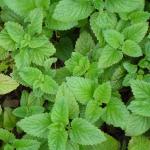Growing Lemon Balm, also Sweet balm,
Melissa Officinalis : Lamiaceae / the mint family
| Jan | Feb | Mar | Apr | May | Jun | Jul | Aug | Sep | Oct | Nov | Dec |
|---|---|---|---|---|---|---|---|---|---|---|---|
| S | S | S | |||||||||
| T | T | T | |||||||||
| P | P | P |
(Best months for growing Lemon Balm in Australia - sub-tropical regions)
- S = Plant undercover in seed trays
- T = Plant out (transplant) seedlings
- P = Sow seed
- Easy to grow. Sow in garden. Sow seed at a depth approximately three times the diameter of the seed. Best planted at soil temperatures between 50°F and 77°F.
- Space plants: 10 inches apart
- Harvest in 8-10 weeks. Cut back tall stems to prevent flowering.
- Compatible with (can grow beside): Good to attract bees
Lemon balm will grow from seed or cuttings. It self seeds readily and can become a nuisance if not checked.
Leaf shape is somewhat like mint and it likes to spread in the same way.
Pleasant lemon scent, released when a leaf is crushed.
Will grow in sun or part-shade. Lemon balm is shallow rooted so needs some water in hot dry weather. Does not like constant wet soil though. Attracts bees.
Culinary hints - cooking and eating Lemon Balm
As a herb tea or added to fruit punch.
Can be used to replace lemon, used sparingly, in desserts and with stewed fruit.
Chop leaves into salad.
Better used fresh than dried.


Your comments and tips